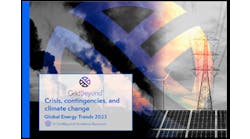The U.S. Department of Energy (DOE) released $104 million from its Assisting Federal Facilities with Energy Conservation Technologies (AFFECT) program this week. This is the first of three planned disbursements from the $250 million program.
Created in 1992, AFFECT is designed to help government agencies reduce energy consumption and carbon emissions as well as save taxpayers money. It does this through building electrification programs and the installation of geothermal heat pumps, on-site solar, battery energy storage systems, microgrids and other similar technologies.
The funds will bring the federal government one step closer to achieving President Biden’s goal of reducing the greenhouse gas emissions 65% at federal facilities by 2030, with all federal buildings achieving net-zero by 2040.
“The federal government is the nation’s largest consumer of energy, and conserving as much power as possible in our buildings and vehicle fleets benefits taxpayers and bolsters our national security,” said U.S. Secretary of Energy Jennifer Granholm, in a statement.
Four microgrid projects awarded funds
Clean energy projects at 31 federal facilities, including those belonging to the Social Security Administration and the U.S. Departments of Defense, Commerce and Transportation, were awarded funds for everything from rooftop solar installations to LED lighting and other energy efficiency projects.
Four of the projects will use the funds to either create or expand existing microgrids, including one at the U.S. Office of Personnel Management (OPM) and three at the Department of Defense (DOD):
- The OPM will install a microgrid at the agency’s Federal Executive Institute in Charlottesville, Virginia, helping to transform the facility into a net-zero campus.
- Creech Air Force Base in Indian Springs, Nevada, will expand its solar and energy storage microgrid to further reduce the base’s emissions and improve its resilience.
- Marine Corps Air Station Beaufort in South Carolina will fund the first phase of a facilitywide microgrid that will optimize the use of alternative fuel sources and renewable energy.
- Naval Air Station Whidbey Island in Washington state will use the funds to add solar, heat pumps and a microgrid to the base, among other technologies designed to displace fossil fuels and increase resilience.
The DOD projects continue the U.S. military’s commitment to achieving resilience and emissions reductions with microgrids. Fort Campbell in Kentucky recently announced it had begun construction on a microgrid, while Yokota Air Base in Japan recently commissioned its new microgrid.
“Successfully adapting to the energy transition is critical for maintaining our strategic advantages,” said Deputy Secretary of Defense Kathleen Hicks. “By rethinking how we generate, distribute and use energy, DOD is making our installations more resilient, better securing our critical infrastructure, and saving money — a win for warfighters and taxpayers alike.”
Big payoffs expected
According to a statement from the DOE, the 31 projects will deliver a cumulative 27 MW of additional clean-energy capacity at federal facilities, more than double the amount created in 2022.
The DOE also expects the projects will save in excess of $29 million in energy and water costs and remove greenhouse gases equivalent to that of 23,042 vehicles.
More than 16 government agencies applied for phase one funds from AFFECT. Phase two applications are expected to open this month, with submissions due in April.








